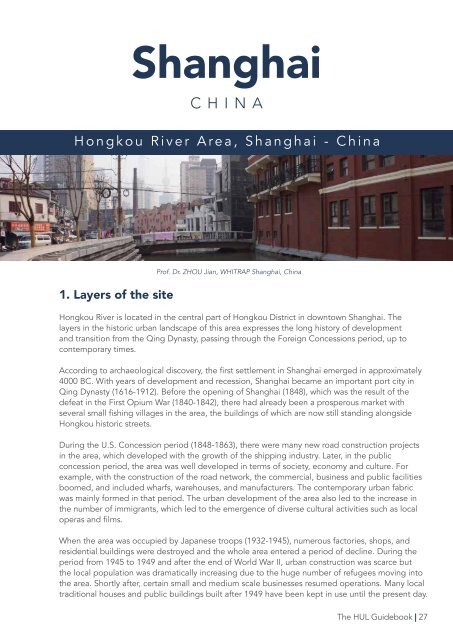GUIDEBOOK
wirey5prpznidqx
wirey5prpznidqx
Create successful ePaper yourself
Turn your PDF publications into a flip-book with our unique Google optimized e-Paper software.
Shanghai<br />
CHINA<br />
Hongkou River Area, Shanghai - China<br />
1. Layers of the site<br />
Prof. Dr. ZHOU Jian, WHITRAP Shanghai, China<br />
Hongkou River is located in the central part of Hongkou District in downtown Shanghai. The<br />
layers in the historic urban landscape of this area expresses the long history of development<br />
and transition from the Qing Dynasty, passing through the Foreign Concessions period, up to<br />
contemporary times.<br />
According to archaeological discovery, the first settlement in Shanghai emerged in approximately<br />
4000 BC. With years of development and recession, Shanghai became an important port city in<br />
Qing Dynasty (1616-1912). Before the opening of Shanghai (1848), which was the result of the<br />
defeat in the First Opium War (1840-1842), there had already been a prosperous market with<br />
several small fishing villages in the area, the buildings of which are now still standing alongside<br />
Hongkou historic streets.<br />
During the U.S. Concession period (1848-1863), there were many new road construction projects<br />
in the area, which developed with the growth of the shipping industry. Later, in the public<br />
concession period, the area was well developed in terms of society, economy and culture. For<br />
example, with the construction of the road network, the commercial, business and public facilities<br />
boomed, and included wharfs, warehouses, and manufacturers. The contemporary urban fabric<br />
was mainly formed in that period. The urban development of the area also led to the increase in<br />
the number of immigrants, which led to the emergence of diverse cultural activities such as local<br />
operas and films.<br />
When the area was occupied by Japanese troops (1932-1945), numerous factories, shops, and<br />
residential buildings were destroyed and the whole area entered a period of decline. During the<br />
period from 1945 to 1949 and after the end of World War II, urban construction was scarce but<br />
the local population was dramatically increasing due to the huge number of refugees moving into<br />
the area. Shortly after, certain small and medium scale businesses resumed operations. Many local<br />
traditional houses and public buildings built after 1949 have been kept in use until the present day.<br />
The HUL Guidebook | 27


